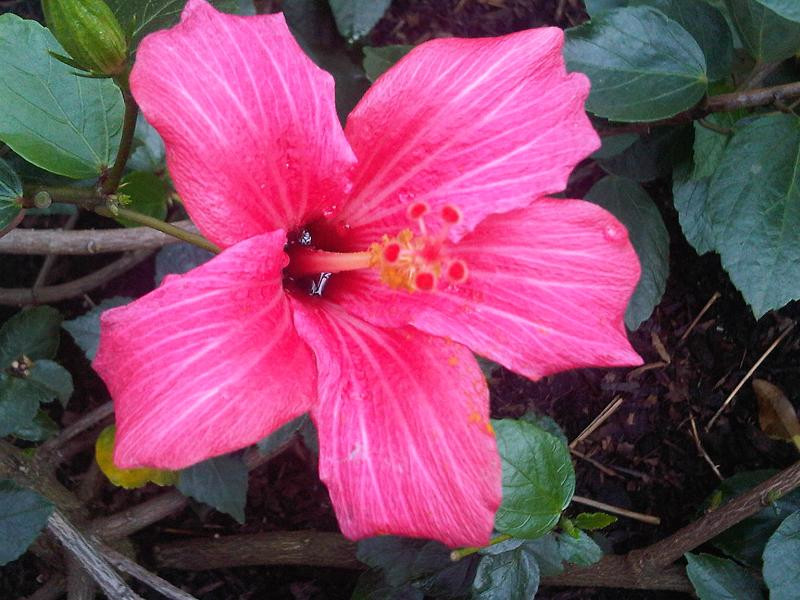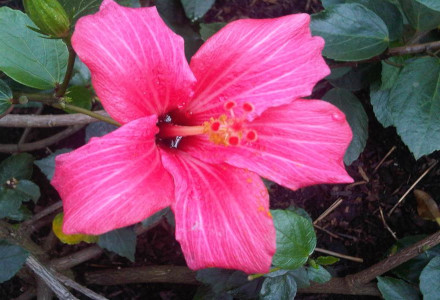
Mandrinette Facts
- Perhaps most notably, the term Mandrinette serves as the common name for a truly remarkable variety of shrub. Among professional researchers, though, it goes by another name. More precisely, it bears the scientific name of the Hibiscus fragilis.
- This remarkable plant also stands out from related species for an unfortunate fact. That’s because of the fact that it represents an extremely rare variety of flora. In fact, at the moment, only 46 known mature specimens of this species exist in the wild.
- The Royal Botanic Gardens, however, is currently attempting to produce seedlings of the incredibly rare Mandrinette. These efforts have so far met with only partial success. Due to their efforts, about 200 plants now exist in several nurseries.
- If all goes as planned, these will one day be reintroduced to the wild. Such an addition would be of invaluable aid to the species. At the moment, due to its situation, the IUCN lists it as Critically Endangered. This status appears on the organization’s Red List.
- Presently, the amazing Mandrinette faces multiple threats to its existence in the wild. One of these consists of competition from invasive species. The greatest threat to this species, nevertheless most likely consists of the ongoing effects of climate change.
Related Articles
Mandrinette Physical Description
The rare but beautiful Mandrinette ranks as an evergreen form of shrub. Not all shrubs make that claim. Those individuals familiar with the gorgeous flora know it as a particularly ornamental species. It achieves this notable appeal due to a combination of several factors.
Unfortunately, its situation makes it impossible to know its maximum growth potential. But the known specimens rank as only moderate-sized for a shrub. Yet this marvel of Nature has absolutely no need to depend on sheer physical size to make it an impressive plant.
The two factors that give the shrub its great appeal are its foliage and its blooms. Firstly, the leaves of the plant develop in great numbers. These further have an impressive glossy, deep green color. These also have a thicker texture than those of related species.
Secondly, the blooms of the remarkable Mandrinette remain quite notable to the eye. Produced singly, these wonders average roughly 2.75 – 4 in (7 -10 cm) in diameter. Each possesses five delicately lined petals. In color, these range from a light pink to a deep red.
- Kingdom: Plantae
- Phylum: Angiosperm
- Class: Eudicots
- Order: Malvales
- Family: Malvaceae
- Genus: Hibiscus
- Species: H. fragilis
Mandrinette Distribution, Habitat, and Ecology
Evidence indicates that the fabulous Mandrinette never had a wide distribution. More precisely, this natural marvel evolved as native to an extremely limited and restricted portion of the globe. That region only covered a small area in the Indian Ocean.
In fact, it only appears to have ever inhabited more than two relatively small islands. Those comparatively isolated locations consisted of the islands of Reunion and Mauritius. Sadly, the gorgeous but fragile shrub appears to no longer exist on Reunion.
Further complicating things for the marvelous Mandrinette is the very nature of its native habitat. That’s due to the fact that, in the wild, it only inhabits exposed, rocky terrain in the mountains. The few spots it grows in also possess a locally dry climate.
The majority of known specimens live on the top of Le Morne Brabant. The rest of them grow in the Corps de Garde Mountains. In both locations, however, reproducing naturally now rarely occurs. Yet, in nurseries propagation is accomplished via cuttings and seeds.
In the natural range of he Mandrinette, the difficulty it has is due to invasive species. These mainly consist of other varieties of hibiscus. Due to their similarity, a tendency to crossbreed exists. Fortunately, efforts to remove the non-native plants seems to succeeded.
Species Sharing Its Range
Check out our other articles on 8 Incredible Asian Mammals, Pesquet’s Parrot, Coyote Gulch, Sea Marigold, Schaus Swallowtail, Barbary Macaque, Anegada ground iguana

